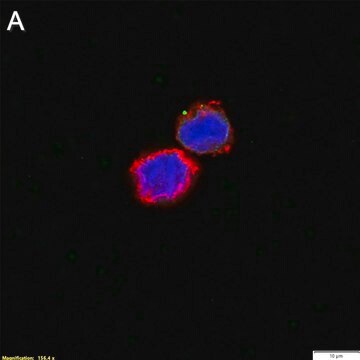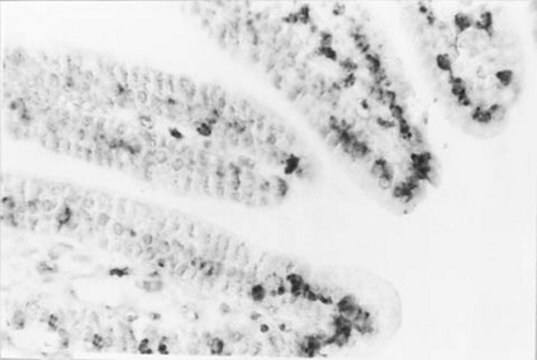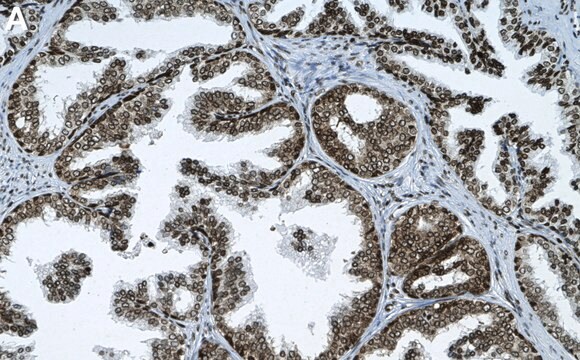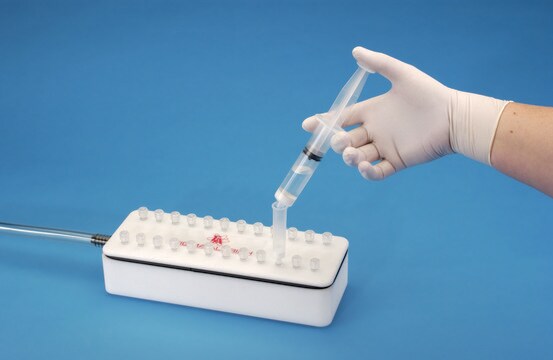MAB3034
Anti-DNA Antibody, single stranded, clone 16-19
clone 16-19, Chemicon®, from mouse
Synonym(s):
Single-Stranded DNA Antibody
Sign Into View Organizational & Contract Pricing
All Photos(1)
About This Item
UNSPSC Code:
12352203
eCl@ss:
32160702
NACRES:
NA.41
Recommended Products
biological source
mouse
Quality Level
antibody form
purified antibody
antibody product type
primary antibodies
clone
16-19, monoclonal
species reactivity (predicted by homology)
all
manufacturer/tradename
Chemicon®
technique(s)
ELISA: suitable
isotype
IgG2aκ
shipped in
wet ice
target post-translational modification
unmodified
Specificity
Single stranded DNA (ssDNA) (poly-deoxythymidine). Shows 90% reactivity to ssDNA and 12% reactivity to dsDNA.
ANTIGEN BINDING PROFILE:
Relative Binding To:
Natural DNA Synthetic homopolymers
dsDNA(a) ssDNA(b) poly(dA) poly(dC) poly(dG) poly(dT) poly(dI) poly(dU)
0.03 0.84 0.02 0.11 0.03 1.00 0.03 0.53
a) Native calf thymus DNA
b) Heat-denatured calf thymus DNA
Nucleic acids were complexed with solid phase mBSA and incubated with anti-DNA antibody. Radioiodinated protein A binding at the highest antibody quantity tested (either 10 μg of purified antibody or a 1:2 culture supernatant dilution) was measured and normalized relative to that determined for the preferred antigen (given a value of 1.0).
BINDING ASSAY
Supernatant was incubated with 32P-end labeled heat-denatured (ss)DNA or duplex (ds)DNA restriction fragments (20 pmoles nucleotides; 16,000 cpm) for one hour at room temperature, followed by precipitation of anti-DNA/DNA complexes with excess rabbit anti-mouse and quantitation of bound [32P] DNA by Chernkov radiation.
ISOELECTRIC POINT = 8.3
ANTIGEN BINDING PROFILE:
Relative Binding To:
Natural DNA Synthetic homopolymers
dsDNA(a) ssDNA(b) poly(dA) poly(dC) poly(dG) poly(dT) poly(dI) poly(dU)
0.03 0.84 0.02 0.11 0.03 1.00 0.03 0.53
a) Native calf thymus DNA
b) Heat-denatured calf thymus DNA
Nucleic acids were complexed with solid phase mBSA and incubated with anti-DNA antibody. Radioiodinated protein A binding at the highest antibody quantity tested (either 10 μg of purified antibody or a 1:2 culture supernatant dilution) was measured and normalized relative to that determined for the preferred antigen (given a value of 1.0).
BINDING ASSAY
Supernatant was incubated with 32P-end labeled heat-denatured (ss)DNA or duplex (ds)DNA restriction fragments (20 pmoles nucleotides; 16,000 cpm) for one hour at room temperature, followed by precipitation of anti-DNA/DNA complexes with excess rabbit anti-mouse and quantitation of bound [32P] DNA by Chernkov radiation.
ISOELECTRIC POINT = 8.3
Immunogen
Epitope: single stranded DNA
Application
ELISA
This antibody is evaluated using ELISA on single stranded DNA from Calf Thymus.
Optimal working dilutions must be determined by end user.
This antibody is evaluated using ELISA on single stranded DNA from Calf Thymus.
Optimal working dilutions must be determined by end user.
Anti-DNA Antibody, single stranded, clone 16-19 is an antibody against DNA for use in ELISA.
Research Category
Apoptosis & Cancer
Apoptosis & Cancer
Research Sub Category
Apoptosis - Additional
Cell Cycle, DNA Replication & Repair
Apoptosis - Additional
Cell Cycle, DNA Replication & Repair
Physical form
0.1 M Tris-Glycine (pH 7.4), 150 nM NaCl with 0.05% sodium azide.
Format: Purified
Storage and Stability
Maintain at 2-8°C in undiluted aliquots for up to 12 months.
Legal Information
CHEMICON is a registered trademark of Merck KGaA, Darmstadt, Germany
Disclaimer
Unless otherwise stated in our catalog or other company documentation accompanying the product(s), our products are intended for research use only and are not to be used for any other purpose, which includes but is not limited to, unauthorized commercial uses, in vitro diagnostic uses, ex vivo or in vivo therapeutic uses or any type of consumption or application to humans or animals.
Not finding the right product?
Try our Product Selector Tool.
Storage Class Code
12 - Non Combustible Liquids
WGK
WGK 1
Flash Point(F)
Not applicable
Flash Point(C)
Not applicable
Certificates of Analysis (COA)
Search for Certificates of Analysis (COA) by entering the products Lot/Batch Number. Lot and Batch Numbers can be found on a product’s label following the words ‘Lot’ or ‘Batch’.
Already Own This Product?
Find documentation for the products that you have recently purchased in the Document Library.
Customers Also Viewed
The SIOD disorder protein SMARCAL1 is an RPA-interacting protein involved in replication fork restart.
Ciccia, A; Bredemeyer, AL; Sowa, ME; Terret, ME; Jallepalli, PV; Harper, JW; Elledge, SJ
Genes & Development null
E2F1 localizes to sites of UV-induced DNA damage to enhance nucleotide excision repair.
Guo, R; Chen, J; Zhu, F; Biswas, AK; Berton, TR; Mitchell, DL; Johnson, DG
The Journal of Biological Chemistry null
DNA replication is altered in Immunodeficiency Centromeric instability Facial anomalies (ICF) cells carrying DNMT3B mutations.
Lana, E; Megarbane, A; Tourriere, H; Sarda, P; Lefranc, G; Claustres, M; De Sario, A
European Journal of Human Genetics null
Evidence of DNA transfer through F-pilus channels during Escherichia coli conjugation.
An-Chi Shu,Chien-Chen Wu,Yi-Yang Chen,Hwei-Ling Peng,Hwan-You Chang,Tri-Rung Yew
Langmuir null
In Xenopus egg extracts, DNA replication initiates preferentially at or near asymmetric AT sequences.
Stanojcic, S; Lemaitre, JM; Brodolin, K; Danis, E; Mechali, M
Molecular and cellular biology null
Our team of scientists has experience in all areas of research including Life Science, Material Science, Chemical Synthesis, Chromatography, Analytical and many others.
Contact Technical Service









